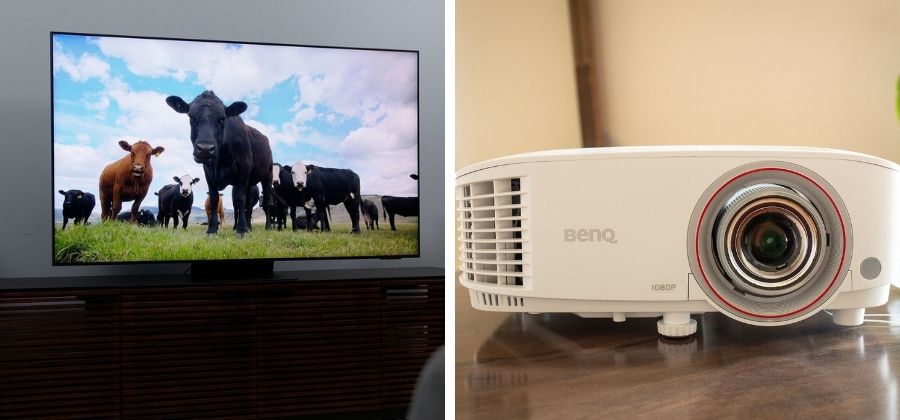There are many benefits to using a projector over a TV.
A projector is typically larger than a TV, providing more space for activities and people at once. The size of the projected image will depend on the distance between the projector and screen or wall that you are projecting onto, allowing for different sizes in different circumstances.
For example, the image can be smaller when you are indoors so it does not take up an entire room. This is useful if you have guests around or want to play games with your family or friends. On the other hand, when outdoors, say at an outdoor cinema event, then being able to project a larger image would help everyone see clearly without having to stand right next to it!
Is a Projector better than a TV?

Projectors have no limits on their movement and can be moved freely, unlike TVs where the cables usually restrict where you can place it. Also, as some projectors are battery powered, they can be mobile and used outside! They also don’t need to have the same amount of space taken up by a TV stand, so those with little or no storage will benefit from using a projector.
What are the advantages of using a projector for movies?
Projectors and TVs use different technologies to display images on-screen. For example, televisions typically use LCD (Liquid Crystal Display) technology whereas projectors tend to use DLP (Digital Light Processing). This means that although both may produce images at similar resolutions, the overall quality of the image produced by a TV will always be less than that of a projector because projectors use a different technology to create their images.
In terms of image quality, televisions tend to produce a higher resolution image than projectors because TVs typically use a technology called ‘Plasma’. Plasma TVs have a much better picture quality and bigger viewing angles compared to DLP projectors. However, because projectors use an entirely different technology to make the images appear on screen, it allows for some other advantages such as being placed anywhere in a room without worrying how far away from the wall or screen you are sitting.
The contrast ratio between TVs and projectors should also be considered when thinking about choosing between these technologies for your home cinema system. The contrast ratio specifies how dark the TV/ projector will display a very dark scene in the movies, compared to how bright it will be when there is no dark content shown.
Essentially, the lower the number for this ratio means that the TV/ projector has less of a difference between light and dark – so images will look less clear. Typically TVs have lower contrast ratios than projectors because they use LCD technology which does not produce as high-contrast an image as DLP projectors do.
Why is a TV better than a projector?
Televisions are better than projectors. They produce higher resolution images, because they use Plasma technology, and television programmes were designed for the technology used in TVs. TVs also tend to have lower contrast ratios than projectors, meaning that images will look less clear on a TV compared to a projector. For example, televisions may only have around 200:1 contrast ratio whereas some projectors can be as high as 50,000:1 or more making images much clearer!
Phew! But I still want to know why is a TV better than a projector?
Well… when it comes down to it – it simply boils down to preference. Some people love the size of their projector screen compared with their TV in their living room or like the fact that projectors are battery powered and can be taken outside. However, some people may prefer a TV because they do not need to change their batteries or get too close to the screen for fear of ‘burning’ their eyes with the brightness.
The main choice comes down to where you will be using your projector – if indoors then perhaps a projector is for you but if outdoors then definitely go for a TV! Furthermore, TVs tend to have lower contrast ratios than projectors, making movie watchers feel like they are seeing more of their favorite actors in real life!
TVs also score higher at home cinema events because most modern TVs allow you to pick up digital radio signals so you don’t even need extra equipment to tune in to your favourite channels! In contrast, projectors require separate expensive equipment which is not ideal for a typical living room.
Furthermore, the majority of TVs have lots of plugs so you can easily connect them up to additional devices such as DVD players and games consoles while some projectors only have a few inputs meaning that it is difficult to hook everything up without spending more money on buying extra cables or adapters. All in all, televisions are just better for movie watchers who want a high definition picture and ease of use.
How to set up the projector correctly?
The key to setting up your projector correctly is finding the place to use it most. A good place for a projector is in an empty room with white or light coloured walls. You should not put your projector too close to the screen; the recommended distance between the screen and projector is about 6 feet (1.8 metres). A way of helping find this distance easily is by leaning down on one side against the wall where you want your picture to appear, put up a tape measure on top of your head and then walk back until you are standing upright while still being able to see your figure clearly on the wall.
If you have more than one room available then try projecting onto different rooms! For example, project from one room to another room through the doorway. People often shy away from this because they think that having a door in the way will distract you or stop you getting a clear picture; however, most projectors are designed to be able to cope with at least some light coming from behind it! If using doors does not work then why not try keeping windows fully or partially covered?
When you’ve found your perfect place for projecting- it’s time to set up everything else! You’ll need to choose where the projector goes on top of its tripod stand. Be sure that none of its parts are obstructed by anything, if any wire needs plugging in make sure there is space around them so you can easily fit them into data ports or free sockets without moving or pushing anything.
You can now finally turn on your projector and adjust the volume, brightness etc. If you’re like me, you’ll want to make sure that all of the equipment looks perfect before watching anything! One last thing- don’t forget to allow time for any warm up processes or heating programmes to complete their cycle correctly otherwise your picture could be messy until it’s finished!
When you’ve found the best place in your house to put a projector, open up Skype, connect with friends and family around the world – let them see what a difference a projector makes!
What are the 2 types of projectors?

Front Projector:
A front projector projects onto screens which lay flat against walls – these screens can be made out of any material so long as they aren’t too thin! A projection surface mustn’t be too thin because the projector will produce heat when in use which can affect it’s performance.
Rear Projector:
A rear projector projects onto screens that are usually hung on walls or held in place by stands – these screens are usually made out of flexible materials such as cloth, plastic and vinyl which allows them to be firmly fixed in position while still being able to move around a little bit to make the picture appear less static. A projection surface must not be too thick either because it could make the picture look blurry if it is distorted due to excess weight/pressure applied.
When choosing your projector take into account all of these factors before you buy! It doesn’t matter if you are indoors or outdoors, front or rear projectors come in all shapes and sizes and different projectors suit different needs. It’s important not to rush into buying one – take your time and consider the space where you’ll be using it, also think about what you’ll be watching on it (for example if you want a high quality movie then choose a projector with high lumens!) If you need help choosing then speak to an expert or look at some projectors that might suit your needs, have fun!
Conclusion:
With all of the things that need to be considered, it can be difficult to decide whether a projector or TV is the right choice for your home. There are pros and cons to each, but one thing is for sure–tahey are both fantastic options. If you are interested in purchasing a projector for your home, please contact us by using our comment box. We are happy to answer any questions you have about the different types of projectors that are available to you.






